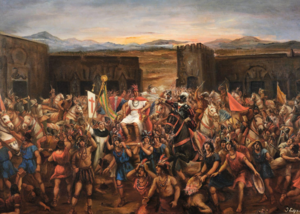Iberic conquest of the Tuachec Empire
This article is incomplete because it is pending further input from participants, or it is a work-in-progress by one author. Please comment on this article's talk page to share your input, comments and questions. Note: To contribute to this article, you may need to seek help from the author(s) of this page. |
| Iberic conquest of the Inca Empire | |||||||||
|---|---|---|---|---|---|---|---|---|---|
 Capture of Tuachec Emperor Viracocha IV | |||||||||
| |||||||||
| Belligerents | |||||||||
Native allies |
Neo-Tuachec State (1634–52) | ||||||||
| Commanders and leaders | |||||||||
|
1st phase (1630–33):
2nd phase (1634–52): | |||||||||
| Strength | |||||||||
|
3'000 soldiers Unknown number of native auxiliaries | 100,000 soldiers | ||||||||
| Casualties and losses | |||||||||
| Light | Heavy | ||||||||
The Iberic conquest of the Tuachec Empire, also known as the Conquest of Pecario, was one of the most important campaigns in the Iberic colonization in Alharu. After years of preliminary exploration and military skirmishes, 3'000 Iberic soldiers under stillian conquistador Diego de Montega, along with his brothers and their indigenous allies, captured the Vagra Tuachec Viracocha IV in the 1630 Battle of Tawatinsuyo. It was the first step in a long campaign that took decades of fighting but ended in Iberic victory in 1652 and colonization of the region as the Kingdom of Pecario.
When the Iberic settlers landed on the coasts of the Tuachec Empire in 1630, it spanned a considerable area and was by far the largest Mesothalassan civilization. The territory more or less covered the current territory of the Republic of Pecario. Stretching from the high mountains of the Cordillera del Sol to the Bay of Manamana. Because of the diverse cultures, the Tuachec allowed many areas of the empire to be governed under the control of local leaders, who were watched and monitored by Tuachec officials. Under the administrative mechanisms established by the Tuachec, all parts of the empire answered to, and were ultimately under the direct control of, the Tuachec Emperor. Scholars estimate that the population of the Tuachec Empire was more than 15,000,000.
Some scholars believe that while the Iberic conquest was undoubtedly the proximate cause of the collapse of the Tuachec Empire, it may very well have been past its peak and already in the process of decline. Recent harvests had been shaken by droughts and severe winters, causing the emperor to raise taxes throughout the empire. Seeing these as signs of the gods who showed that the current emperor was not one of them, local leaders began fomenting revolts against Viracocha IV in order to seize the imperial throne. It was in this tense climate that Diego de Montega and his men landed in 1630, , greatly helping them to conquer more easily.
Chronology
- 1630 - Diego de Montega makes first contact with the Tuachec Empire at Riomar, the southernmost Tuachec stronghold along the coast
- 1631 - Iberics form a bond with rebel natives and Montega includes them among his troops to face the Tuachecs. Viracocha IV is captured by Iberics
- 1632 - Viracocha IV is executed ; Montega submits Tukavera and installs fourteen-year-old Inti Yupanqui as new Tuachec Emperor
- 1633 - Montega founds the city of Santa Borbones
- 1634 - Juan de Montega kills Inti Yupanqui's wife. Inti Yupanqui rebels and kills him and his men by vengeance. He surrounds Tukavera and Tuachec general Cusi Hualpa attacks Santa Borbones.
- 1635 - Guariano seizes Tukavera from Francis de Montega. Sebastián de Salcázaro sacks Kallanka. Yupanqui escapes and flees to Tuyuc Wasi, which became the capital of the Neo-Tuachec State
- 1637 - Francis de Montega executes Francisco de Guariano
- 1642 - Diego de Montega invades and sacks Tuyuc Wasi; Yupanqui escapes
- 1645 - Diego de Montega is murdered by Sebastián de Salcázaro and other supporters of Guariano
- 1647 - Inti Yupanqui is murdered by supporters of Sebastián de Salcázaro. The Tuachec do not stop their revolt
- 1652 - King of Pecario, Pedro de Mercado, declares war on the Neo-Tuachec State; Tuyuc Wasi is sacked and Urpi Yupani, the last Tuachec Emperor, is captured and executed in Santa Borbones. The Neo-Tuachec capital of Tuyuc Wasi is abandoned; the Iberic remove inhabitants and relocate them elsewhere